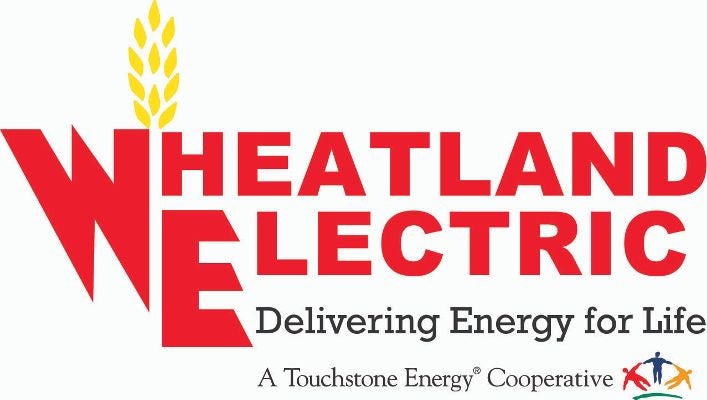FOR IMMEDIATE RELEASE -
January 21, 2020 - (Scott City, KS)
Wheatland Electric Cooperative, Inc. announced that a rate adjustment proposal was presented to the Board of Trustees on January 21, 2020, and passed unanimously. A cost-of-service study was completed by Mike Searcy of C.H. Guernsey & Associates. As announced in the December 2019 issue of the Kansas Country Living, the January 21, 2020 board meeting of Wheatland Electric Cooperative, Inc. was open to all members during the section of the meeting when the rate adjustment proposal was discussed and voted upon.
During the presentation, Searcy demonstrated the rates of all classes of service and how rate adjustments were applied to the various classes. The board, staff and members in attendance asked Searcy numerous questions about the proposed rate adjustments. Members also asked how the proposed rate adjustments would be implemented. Searcy explained the rate adjustment will be phased-in over a three-year period: 2020, 2021 and 2022.
After questions were answered, the board discussed the matter thoroughly and decided it was in the best interest of the co-op and its members to adopt the rate adjustment proposal. Phase one of the rate adjustment will go into effect on April 1, 2020.

Cost of Doing Business
The cost-of-service study showed the co-op’s revenue requirement did not need to increase, which is why we sought a revenue neutral rate adjustment, not a rate increase. However, the results of the study showed some rate classes needed adjustments to accurately cover their contribution toward the cost of providing electric service.
Kilowatt-hour (kWh) Charge and Service Availability Charge
Two parts of the rate adjustment proposal are the Energy Charge (per kWh) and the Service Availability Charge. The current tariffs relied too heavily on the Energy Charge (per kWh) to cover many of our fixed costs. Since energy usage is extremely variable, we redesigned the new tariffs to be fairer and more efficient. As you can see in the included charts, the Energy Charge (per kWh) has been lowered and the Service Availability Charge has been raised. The Service Availability Charge is a fixed monthly charge designed to recover the costs of providing equipment, materials, labor and business overhead necessary to serve each meter, regardless of the amount of electricity (kWh) consumed. These fixed costs are the same for a member using 10 kWh or 5,000 kWh.

Lighting Tariffs
Wheatland currently has as a long list of different types and sizes of lighting. Each individual light requires replacement lights, and inventory, which carries a cost. Reducing the number of lighting rates and sizes allows Wheatland to be more efficient and to lower costs. In addition, Wheatland is also moving to LEDs (light-emitting diode) as our primary lighting type. LEDs are more energy efficient, meaning they are good for members and the environment.
Time of Day (TOD) Tariff
The purpose of time of day rates is to encourage members to shift their usage away from Wheatland’s peak hours. When they do so, Wheatland saves on the cost of power it purchases and can pass this savings on to members through the TOD rate. The existing rate design balanced the need to correctly design the rate against the impact on existing members at the time of the last rate change. This was beneficial and a way to move toward a better pricing structure over time, but it did allow some members to move to the TOD rate and save money without moving any of their load to off-peak hours. The new rate better encourages the desired change in usage behavior.
Primary Facilities Charge Rider
Rates are designed to recover the cost of providing service to each member. The vast majority of members are what is known as “secondary metered,” meaning the meter is located on the “secondary side” of the transformer. A small number of large members have what is known as “primary meters.” This means that the transformer is on the “primary side” of the meter.
For large general service rate members who are primary metered, the co-op is now including a “primary discount.”

Power Cost Adjustment (PCA)
Wheatland’s average cost of wholesale power varies monthly depending on both the demand charges and fuel charges from our wholesale supplier Sunflower Electric. The co-op uses a Power Cost Adjustment (PCA) to pass along these fluctuations in wholesale power costs. The PCA appears on your monthly bill as a separate line item (either a charge or credit). Because power costs have been falling, in most future months the PCA would likely be negative. So as a part of this rate change, Wheatland moved this credit PCA amount into actual stated rates. This is NOT an increase. This rate change will allow the co-op to “smooth out” the PCA by looking at the average usage over time to reduce variability. This charge will keep the PCA more consistent in the future without wide swings up or down.
Property Tax Adjustment (PTA)
The property tax adjustment works in a similar fashion. It passed through to members changes in the property taxes paid by Wheatland. It too is being restated so that the factor will become smaller and this difference is moved into rates. And as is the case with the PCA, there is no difference to the total bill paid by the member because of this change.
Irrigation Tariff
The rate class seeing a small increase for the average member is the Irrigation rate class. Wheatland’s cost of serving irrigation members is higher than its cost recovery in rates. Rather than wait until the next cost-of-service study, Wheatland is increasing irrigation rates a very small amount now (just over 1% for the average member).


Contact Us with Questions
The charts throughout the article demonstrate the existing rates and the new adjusted rates that will go into effect on April 1, 2020.
Adjusting electric rates is a matter of paramount importance. The co-op’s board, and management have evaluated this issue for some time and decided the adjustments were necessary for the responsible operation of the co-op — both for the quality and reliability of service and the financial integrity of the cooperative.
Please feel free to contact your local Wheatland Electric Office, to visit about questions, concerns or suggestions you may have.
Wheatland Electric Cooperative, Inc., a member owned distribution cooperative headquartered in Scott City, KS, was established in 1948 as a distribution and power cooperative, in the state of Kansas. Today, Wheatland Electric serves more than 33,000 electric meters in 16 different counties and maintains over 4000 miles of distribution power lines across Western and South Central Kansas. Together, with the help of our members, Wheatland Electric is committed to building a better and stronger rural America. For more information about Wheatland visit www.weci.net.

